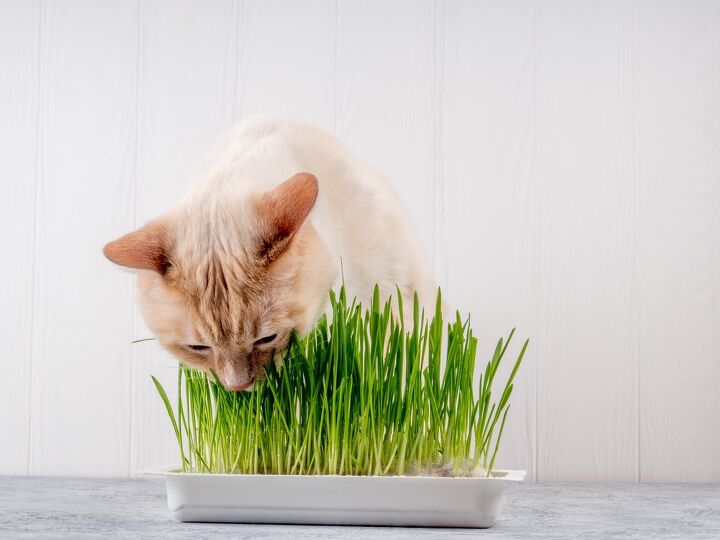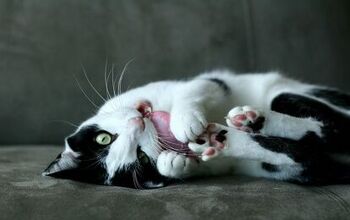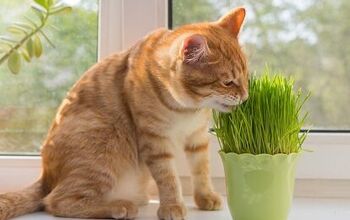Cat Grass and Safe Alternatives

I don’t know about you, but my cats are crazed for grass. Cat grass, yard grass… the moment decent weather hits their inner Holstein kicks in and they’re chowing down on the green stuff every chance they get. Of course, the difference between cows and cats is that with the latter, it’s always followed by retching and heaving the moment they come indoors. So, with this known outcome in mind, what is it about these grasses that is so enticing to cats? And what’s a safe substitute for when winter weather prevents backyard noshing? Let’s start with a bit of a backgrounder.
What is Cat Grass?
That lush pot of tall leafy greens you just picked up at your pet store is in fact a mixture of grasses that have been specifically grown from seeds free from toxins and pesticides. Unlike your back lawn that may (or hopefully doesn’t) have chemical treatments, cat grass is grown indoors under controlled conditions so you know what you’re serving up, is both healthy and safe. And it’s not your standard turf-style grass but a blend of wheat, rye, and barley.
Benefits to Eating Cat Grass?
While cat grass is not integral to your pet’s diet, it does provide roughage that helps move things along at both ends. And although there’s no certainty as to why it’s such a draw for our feline friends, it’s thought that in the wild, consuming greens helped them regurgitate the non-digestible remnants of their prey. Apparently old habits die hard, but there are still some benefits to noshing down on cat grass including the reduction of hairballs and regulation of bowel movements.
What are Safe Alternatives?
While cat grass is easy to grow, it doesn’t really last all that long and that can make finding a healthy green plant, somewhat hit-or-miss when grocery shopping. So, rather than have your feline turn your houseplants into her own private salad bar, consider growing your own and/or using plants that have a longer “shelf life” than the usual fragile grasses. It’s easy to do, most will germinate quickly and be ready for noshing within a few weeks. Best of all, some have a seriously longer life cycle than standard cat grass, can offer a range of health benefits and even offer up a variety of textures and smells your kitty will appreciate.
Below are just a few of these alternatives. All have their own unique health benefits and a range of flavor combos that are sure to have your feline feeling “regular” in no time:
Alfalfa: this leafy grass is known to be highly palatable to most cats and can also help prevent kidney disease.
Oat grass: another favorite grass that’s not only tasty but also high in protein, fiber, and even antioxidants.
Cat Thyme: yes, there’s a thyme plant for your feline. Apparently, cats love the aroma because it imparts a euphoric feel. They can also eat the plant for a more chill, sedate vibe.
Mint: surprise! Cats actually love the smell of mint and will chew, tear and even roll around in it as part of their roughage routine.
Parsley: why not share this versatile herb with your cat? Ideal for fighting infections, parsley is also good for preventing urinary tract infections, anemia and helping with kidney issues
Basil: that deliciously scented herb is also a favorite with cats who are more likely to nibble on leaves than devour the plant.
Licorice Root: while you may not be familiar with this wonder grass, cats do enjoy it and even better, it’s a known anti-inflammatory that can help soothe the aches and pains of arthritic pets.
But it’s important to understand that not all grasses, herbs and plants are safe for your cat (or dog) to eat, sniff or lick. Before you share your herb garden with Fifi, be sure to google the plant and learn whether it’s safe to eat, should be eaten in moderation, or avoided at all costs.

Sharing space with three seriously judgy Schnoodles and a feline who prefers to be left alone. #LivingMyBestLife
More by Mary Simpson























